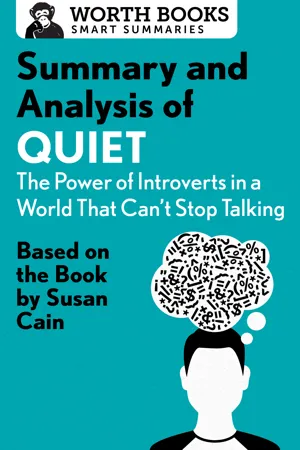Summary
According to Susan Cain, pretty much everything in our lives—from our relationships and our careers to our finances and even our health—is inextricably affected by where we fall on the introvert-extrovert spectrum. Reflecting on the standard definitions of introvert and extrovert, wherein introvert is defined as one who is shy, sensitive, and submissive, and extrovert is defined as one who is an outgoing, dominant risk-taker, Cain acknowledges not everyone in the research community agrees with these definitions. Nor do these terms apply to individuals in a clear-cut or consistent way.
Still, there are some things on which most psychologists would agree. For instance, most researchers contend that introverts require far less external stimulation than extroverts. Whereas introverts may be content to sit quietly reading a book or meeting up with a close friend for coffee, extroverts tend to prefer large groups of people and are far more active in their leisure-time activities.
The two also approach their work lives differently. Introverts tend to be very deliberate when tackling a project. They tend to focus on one thing at a time, methodically working their way through a task or problem that needs to be solved. Extroverts tend to dive in, work quickly, and take risks, in large part because they require more reward stimuli than introverts to achieve peak functionality.
Social style is also a good indicator of where someone sits on the introvert-extrovert scale. Extroverts love company, tend to be assertive, prefer talking to listening, and are rarely at a loss for words. Introverts, on the other hand, listen more than they talk, think before they speak, and often prefer to communicate in writing rather than in person. None of which is to say introverts lack in social skills; they simply prefer deep discussion with close friends to small talk with strangers.
Despite research demonstrating that one third to one half of America’s population is made up of introverts, we remain a nation consumed by the Extrovert Ideal: the notion that our culture, our institutions, and our personalities are better served by the gregarious, unreserved, in-your-face alpha traits of the extroverted. This thinking often keeps us from recognizing the value and the gifts of introverts. Susan Cain wants to change that.
In her work as a lawyer and a negotiation consultant, Cain helped introverts—herself included—optimize their unique characteristics and talents to create rich, full lives.
The aim of Quiet is to clear up some of the confusion and empower introverts to be their best selves.
1. THE RISE OF THE “MIGHTY LIKEABLE FELLOW”
How Extroversion Became the Cultural Ideal
The author begins our journey by tracing America’s cultural evolution at the turn of the nineteenth century, from a society in which inner morality was most highly regarded to one in which a particularly charismatic personality type was considered superior—and the Extrovert Ideal was born.
According to historian Warren Susman, we drifted from a Culture of Character into a Culture of Personality beginning in the early twentieth century. And in the process, Cain argues, we set ourselves up for a boatload of personal and social anxieties from which we would never fully recover.
In Susman’s concept of a Culture of Character, the ideal self was serious, honorable, studious, and disciplined. But the urbanization of America in the early 1900s put us elbow to elbow with our neighbors: those we knew and those we didn’t. Suddenly, what others thought of us seemed critical to our very existence. This led to a shift from a Culture of Character into a Culture of Personality, where the ideal self was gregarious, social, and charismatic.
Cain defines the Extrovert Ideal as the all-encompassing notion that one’s ideal self is outgoing, entertaining, and always comfortable in the spotlight. She ponders the rise of the Extrovert Ideal and this cultural shift through the lens of the self-help movement, which was beginning to churn in the 1920s.
The shift in culture from a character-driven to a personality-driven landscape pushed things into high gear. Popular guides that focused on the importance of developing integrity and inner virtue were replaced by those extolling the benefits of charm and popularity. Key words found in earlier guides included: citizenship, duty, and honor. The “new and improved” guides used words such as fascinating, stunning, and forceful.
The world of psychology was also feeling the pressure to make room for this new focus on personality. Gordon Allport developed a diagnostic test to measure social dominance, and Carl Jung published his groundbreaking book Psychological Types, in which he popularized the terms introvert and extrovert to describe those who were quiet and those who were anything but. Some might argue that the most influential effort to package personality was Alfred Adler’s theory of the “inferiority complex,” which he used to describe those who felt inadequate in their surroundings. Americans jumped at the opportunity to name their anxieties.
The Extrovert Ideal is alive and well even today, and the pressure to sell ourselves continues. An individual’s social status, income, and career are used all too often to define one’s self-worth—a task that becomes twice as complex as we struggle to establish who we are online and offline.
2. THE MYTH OF CHARISMATIC LEADERSHIP
The Culture of Personality, a Hundred Years Later
Eager to understand why our society holds extroverted behavior in such high regard as a prerequisite for strong leadership—and to examine whether there is any merit to this thinking—Cain devises a plan to visit a handful of wildly successful extroverts. Her findings? The Extrovert Ideal is not always popular in leadership circles. In fact, the extrovert model of leadership can be detrimental.
Cain enrolls herself in one of Tony Robbins’s motivational seminars, “Unleash the Power Within,” for the not-so-small sum of $895. This secures her a general admission seat “in the back.” Others have paid $2,500 for a Diamond Premiere Membership and a seat closer to Tony. According to Cain, Robbins exemplifies the Extrovert Ideal. Hi...
